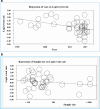Helicobacter pylori infections in Ethiopia; prevalence and associated factors: a systematic review and meta-analysis
- PMID: 30630433
- PMCID: PMC6327617
- DOI: 10.1186/s12876-018-0927-3
Helicobacter pylori infections in Ethiopia; prevalence and associated factors: a systematic review and meta-analysis
Abstract
Background: Helicobacter pylori (H.pylori) infections are prevalent and recognized as major cause of gastrointestinal diseases in Ethiopia. However, Studies conducted on the prevalence, risk factors and other clinical forms of H.pylori on different population and geographical areas are reporting conflicting results. Therefore, this review was conducted to estimate the pooled prevalence of H.pylori infections and associated factors in Ethiopia.
Methods: PubMed, Embase, Google scholar, and Ethiopian Universities' repositories were searched following the Preferred Items for Systematic review and Meta-analysis (PRISMA) guideline. The quality of included studies was assessed using the Newcastle-Ottawa Scale in meta-analysis. Heterogeneity between studies was assessed using Cochrane Q test and I2 test statistics based on the random effects model. Comprehensive meta-analysis (CMA 2.0) and Review Manager (RevMan 5.3) were employed to compute the pooled prevalence and summary odds ratios of factors associated with of H.pylori infection.
Results: Thirty seven studies with a total of 18,890 participants were eligible and included in the analysis. The overall pooled prevalence of H.pylori infection was 52.2% (95% CI: 45.8-58.6). In the subgroup analysis by region, the highest prevalence was found in Somalia (71%; 95% CI: 32.5-92.6) and the lowest prevalence was reported in Oromia (39.9%; 95% CI: 17.3-67.7). Absence of hand washing after toilet (OR = 1.8, 95% CI; 1.19-2.72), alcohol consumption (OR = 1.34, 95% CI; 1.03-1.74) and gastrointestinal (GI) symptoms (OR = 2.23, 95% CI; 1.59-3.14) were associated with H.pylori infection. The trend of H.pylori infection showed a decreasing pattern overtime from 1990 to 2017 in the meta-regression analysis.
Conclusion: The prevalence of H.pylori infection remains high; more than half of Ethiopians were infected. Although the trend of infection showed a decreasing pattern; appropriate use of eradication therapy, health education primarily to improve knowledge and awareness on the transmission dynamics of the bacteria, behavioral changes, adequate sanitation, population screening and diagnosis using multiple tests are required to reduce H.pylori infections. Recognizing the bacteria as a priority issue and designing gastric cancer screening policies are also recommended.
Keywords: Ethiopia; Helicobacter pylori; Meta-analysis; Systematic review.
Conflict of interest statement
Ethics approval and consent to participate
Not applicable.
Consent for publication
Not applicable.
Competing interests
The authors declare that they have no competing interests.
Publisher’s Note
Springer Nature remains neutral with regard to jurisdictional claims in published maps and institutional affiliations.
Figures








Similar articles
-
Prevalence of intestinal parasites and Helicobacter pylori co-infection in people with gastrointestinal symptoms in Africa: a systematic review and meta-analysis.BMC Infect Dis. 2025 Jan 3;25(1):20. doi: 10.1186/s12879-024-10432-x. BMC Infect Dis. 2025. PMID: 39754070 Free PMC article.
-
Prevalence and risk factors of Helicobacter pylori infection in military personnel: a systematic review and meta-analysis.Indian J Pathol Microbiol. 2022 Jan-Mar;65(1):23-28. doi: 10.4103/IJPM.IJPM_1084_20. Indian J Pathol Microbiol. 2022. PMID: 35074961
-
Intestinal parasitic co-infections associated with Helicobacter pylori among paediatric patients with gastrointestinal illness attending a general hospital in southern Ethiopia.BMC Pediatr. 2024 Aug 23;24(1):545. doi: 10.1186/s12887-024-05026-0. BMC Pediatr. 2024. PMID: 39180069 Free PMC article.
-
Individual and household correlates of Helicobacter pylori infection among Young Ethiopian children in Ziway, Central Ethiopia.BMC Infect Dis. 2020 Apr 25;20(1):310. doi: 10.1186/s12879-020-05043-1. BMC Infect Dis. 2020. PMID: 32334539 Free PMC article.
-
Prevalence and determinants of hyperemesis gravidarum among pregnant women in Ethiopia: A systematic review and meta-analysis.PLoS One. 2024 Dec 3;19(12):e0314783. doi: 10.1371/journal.pone.0314783. eCollection 2024. PLoS One. 2024. PMID: 39625915 Free PMC article.
Cited by
-
Prevalence of Helicobacter pylori infection and effectiveness of first-line triple eradication therapy among dyspeptic patients at hospitals in Hawassa City, Ethiopia: a cross-sectional follow-up study.Gut Pathog. 2024 Apr 27;16(1):23. doi: 10.1186/s13099-024-00618-8. Gut Pathog. 2024. PMID: 38678267 Free PMC article.
-
The impacts of probiotics in eradication therapy of Helicobacter pylori.Arch Microbiol. 2022 Nov 7;204(12):692. doi: 10.1007/s00203-022-03314-w. Arch Microbiol. 2022. PMID: 36344628 Free PMC article. Review.
-
Diagnostic Challenges of Helicobacter pylori Infection in Ethiopia: A Community-Based Cross-Sectional Study.Can J Gastroenterol Hepatol. 2022 Jun 2;2022:4013020. doi: 10.1155/2022/4013020. eCollection 2022. Can J Gastroenterol Hepatol. 2022. PMID: 36247045 Free PMC article.
-
Prevalence of H. pylori among asymptomatic HIV-positive and negative individuals in Central Ethiopia and efficacy of eradication therapy.IJID Reg. 2022 Jan 19;2:169-174. doi: 10.1016/j.ijregi.2022.01.007. eCollection 2022 Mar. IJID Reg. 2022. PMID: 35757079 Free PMC article.
-
Role of Helicobacter pylori infection in the manifestation of old age-related diseases.Mol Genet Genomic Med. 2020 Apr;8(4):e1157. doi: 10.1002/mgg3.1157. Epub 2020 Feb 17. Mol Genet Genomic Med. 2020. PMID: 32067423 Free PMC article. Review.
References
-
- Hunt RH, Xiao SD, Megraud F, et al. Helicobacter pylori in developing countries, world gastroenterology organisation global guideline. J Gastrointestin Liver Dis. 2011;20(3):299–304. - PubMed
Publication types
MeSH terms
LinkOut - more resources
Full Text Sources
Medical

